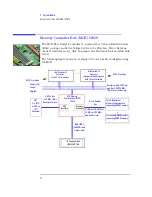
47
2 System Board
Memory Controller Hub (MCH) 82820
MCH will scrub single bit errors by writing the corrected value back into
DRAM for all reads when hardware scrubbing is enabled. This, however,
does not include reads launched in order to satisfy an AGP aperture
translation.
ECC can only be enabled when all RDRAM devices are populated in a system
that supports the extra two data bits used to store the ECC code.
Rambus Channel
The single Direct Rambus Channel is a 16-bit wide bidirectional
bus—commands and data can be transferred in both directions
simultaneously. The Rambus Channel is connected to the Memory
Expansion Card connector and to the MCH chip.
The channel runs at 300 or 400 MHz and supports up to 32 Rambus devices
(individual chips) and one MTH (Memory Translator Hub) for DIMM
sockets. The maximum available data bandwidth is 1.6GB/sec at 400 MHz.
RIMM Memory Slots
RDRAM models of the
HP Kayak XM600
have two RIMM memory sockets,
RIMM0 and RIMM1, available for installing RDRAM memory modules
If RDRAM memory is being used, there must be no Memory Expansion
Card in the SDRAM Memory Expansion Card Socket.
A maximum of two RDRAM modules can be installed in the
HP Kayak
XM600 PC Workstation
.
If only one RDRAM module is being used, it must be inserted in RIMM0 (the
socket nearest the processor). A Continuity module must be inserted in the
RIMM1 socket and an RDRAM Terminator Module in the third memory
socket (reserved for Memory Expansion Card).
If two RDRAM modules are installed, they must be inserted in the two
sockets nearest the processor (RIMM0 and RIMM1) and an RDRAM
Terminator Module in the third memory socket.
An RDRAM module must never be inserted in the SDRAM Memory
Expansion Card socket—if it is, an error message will be displayed during
the POST phase and the system will not boot.
RIMM1
RIMM0
















































